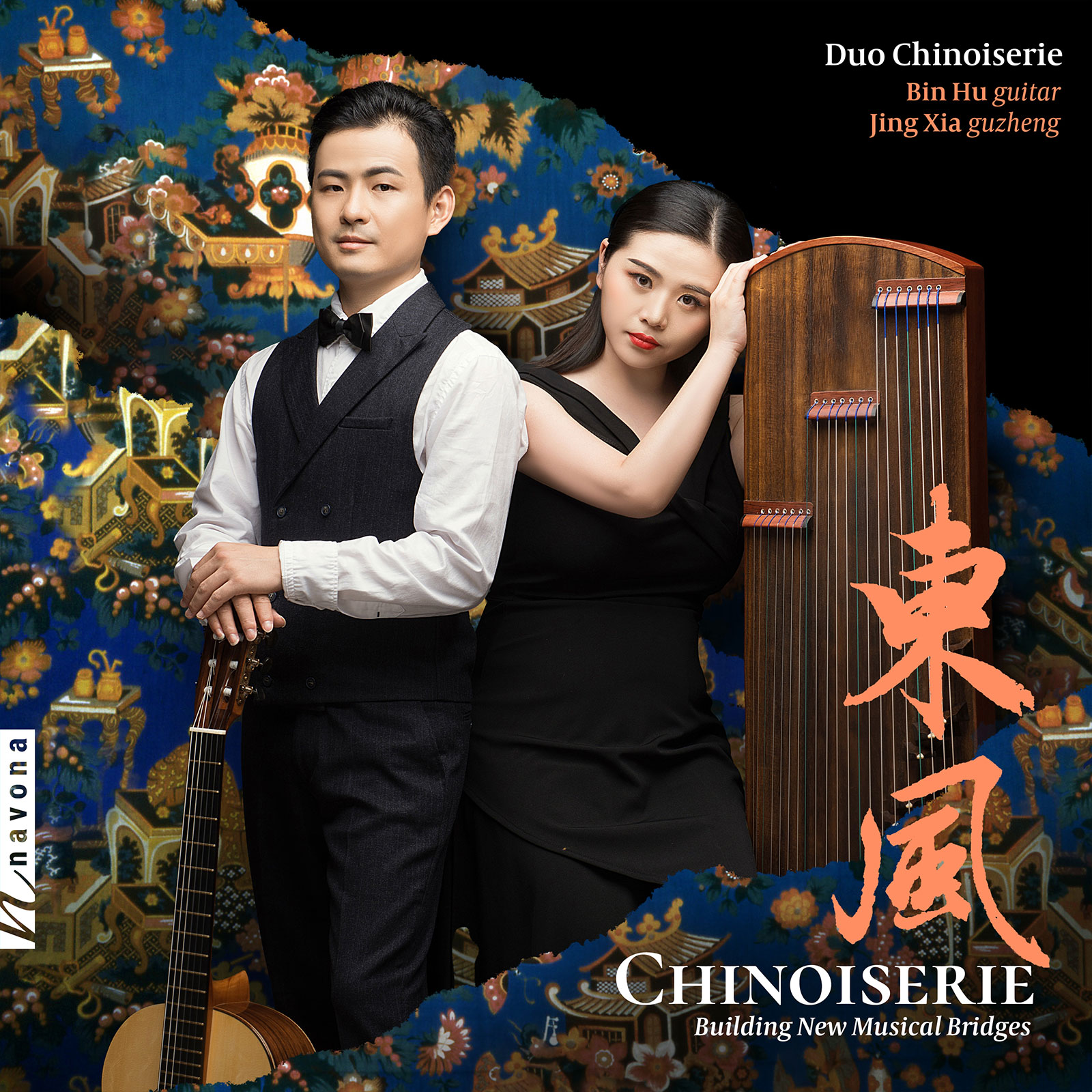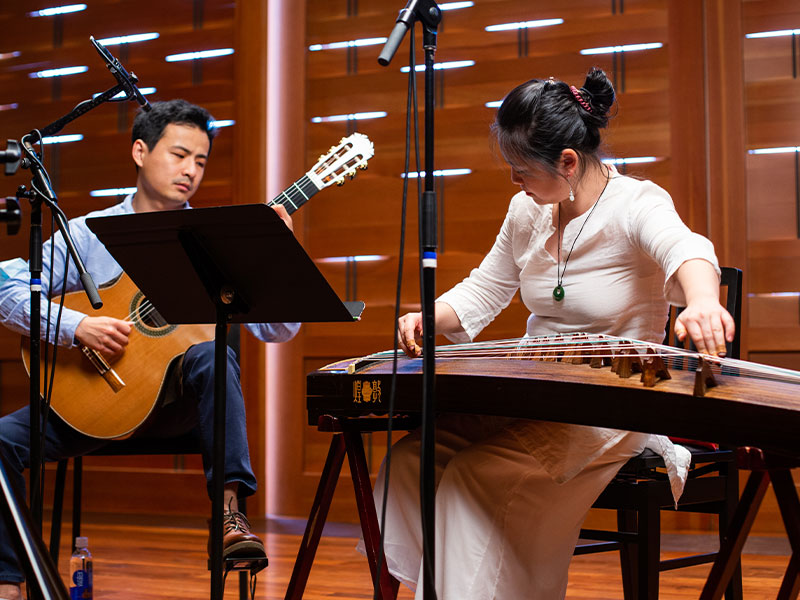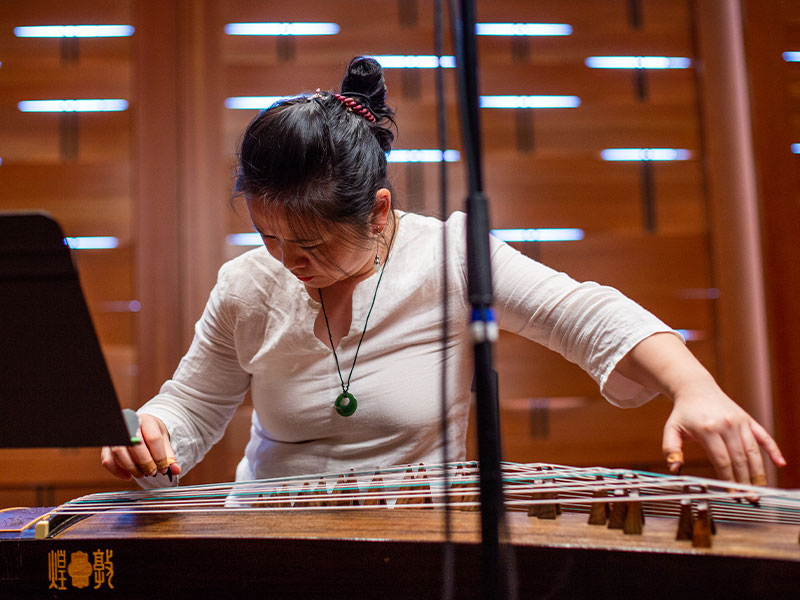Chinoiserie
Duo Chinoiserie
Bin Hu guitar
Jing Xia guzheng
A true melding of Eastern and Western cultures, Duo Chinoiserie’s CHINOISERIE combines the Chinese guzheng and European classical guitar to create an inspired new canon of classical repertoire. A bold and carefully handpicked selection of compositions—including new arrangements of Granados, de Falla, and Debussy alongside a transcription of Goss and new works by Assad, Duplessy, and Nakanishi—explores the instruments’ dialogue and complementary textures while uniting contrasting musical styles into a cohesive, well-defined whole. As the guzheng’s crisp, plucky clarity interplays with the guitar’s chords, even the most well-known classical pieces become fresh and energized, born anew with a unique and visionary sound.
Listen
Stream/Buy
Choose your platform
Performance Video
Zhong Kui’s Journey – Duo Chinoiserie
Track Listing & Credits
| # | Title | Composer | Performer | |
|---|---|---|---|---|
| 01 | Mulan | Sérgio Assad | Duo Chinoiserie | Bin Hu, guitar; Jing Xia, guzheng | 8:41 |
| 02 | Cantigas de Santiago: Quen a Virgen ben servirá | Stephen Goss, arr. Duo Chinoiserie | Duo Chinoiserie | Bin Hu, guitar; Jing Xia, guzheng | 3:33 |
| 03 | Cantigas de Santiago: Ondas do mare de Vigo | Stephen Goss, arr. Duo Chinoiserie | Duo Chinoiserie | Bin Hu, guitar; Jing Xia, guzheng | 2:12 |
| 04 | Cantigas de Santiago: Como póden per sas culpas | Stephen Goss, arr. Duo Chinoiserie | Duo Chinoiserie | Bin Hu, guitar; Jing Xia, guzheng | 1:28 |
| 05 | Cantigas de Santiago: Ay ondas que eu vin ver | Stephen Goss, arr. Duo Chinoiserie | Duo Chinoiserie | Bin Hu, guitar; Jing Xia, guzheng | 2:09 |
| 06 | Cantigas de Santiago: Non é gran cousa se sabe | Stephen Goss, arr. Duo Chinoiserie | Duo Chinoiserie | Bin Hu, guitar; Jing Xia, guzheng | 4:29 |
| 07 | “Oriental” from Danzas Españolas, op. 37 | Enrique Granados, arr. Duo Chinoiserie | Duo Chinoiserie | Bin Hu, guitar; Jing Xia, guzheng | 5:05 |
| 08 | El amor brujo: Danza del terror | Manuel de Falla, arr. Duo Chinoiserie | Duo Chinoiserie | Bin Hu, guitar; Jing Xia, guzheng | 1:59 |
| 09 | El amor brujo: Canción del fuego fatuo | Manuel de Falla, arr. Duo Chinoiserie | Duo Chinoiserie | Bin Hu, guitar; Jing Xia, guzheng | 1:46 |
| 10 | El amor brujo: Danza ritual del fuego | Manuel de Falla, arr. Duo Chinoiserie | Duo Chinoiserie | Bin Hu, guitar; Jing Xia, guzheng | 4:08 |
| 11 | The Girl with the Flaxen Hair | Claude Debussy, arr. Duo Chinoiserie | Duo Chinoiserie | Bin Hu, guitar; Jing Xia, guzheng | 2:36 |
| 12 | Golliwogg’s Cakewalk | Claude Debussy, arr. Duo Chinoiserie | Duo Chinoiserie | Bin Hu, guitar; Jing Xia, guzheng | 2:54 |
| 13 | Inari: Invocation | Yusuke Nakanishi | Duo Chinoiserie | Bin Hu, guitar; Jing Xia, guzheng | 3:26 |
| 14 | Inari: Fox’s Dance | Yusuke Nakanishi | Duo Chinoiserie | Bin Hu, guitar; Jing Xia, guzheng | 1:12 |
| 15 | Inari: Festival | Yusuke Nakanishi | Duo Chinoiserie | Bin Hu, guitar; Jing Xia, guzheng | 3:13 |
| 16 | Zhong Kui’s Regrets | Mathias Duplessy | Duo Chinoiserie | Bin Hu, guitar; Jing Xia, guzheng | 6:04 |
| 17 | Zhong Kui’s Journey | Mathias Duplessy | Duo Chinoiserie | Bin Hu, guitar; Jing Xia, guzheng | 4:55 |
Recorded July 25-27, 2021 at the Shalin Liu Performance Center MA
Session Producer, Editing, Mixing & Mastering Brad Michel
Session Engineer Tom Stephenson
Liner Notes by Kathy Acosta Zavala
Executive Producer Bob Lord
Executive A&R Sam Renshaw
A&R Director Brandon MacNeil
A&R Morgan Santos
VP of Production Jan Košulič
Production Director Levi Brown
Audio Director Lucas Paquette
Production Assistant Martina Watzková
VP, Design & Marketing Brett Picknell
Art Director Ryan Harrison
Design Edward A. Fleming
Publicity Patrick Niland, Aidan Curran
Content Manager Sara Warner
Artist Information

Duo Chinoiserie
Founded in 2016, Duo Chinoiserie is a unique pairing that combines the Chinese guzheng and the European classical guitar. This duo reproduces the elegance of the Chinoiserie style and brings the best of Eastern and Western culture together through music. Its bold and carefully handpicked selection of repertoire explores the instruments’ dialogue and complementary textures while uniting contrasting musical styles into a cohesive, well-defined one.
Notes
Reframing Chinoiserie: Building New Musical Bridges
The boom in trade between Europe and East Asia in the 17th and 18th centuries allowed an exchange of economic and cultural commodities. Within this historical context, the style of Chinoiserie emerged, representing the European fantasy of East Asian cultures at a time when international travel was not common. Inspired by it, Duo Chinoiserie is a unique pairing that combines the Chinese guzheng and the European classical guitar. This duo reproduces the elegance of the Chinoiserie style and brings the best of Eastern and Western culture together through music. The texturing, combination, and dialogue between both instruments are displayed on this album through a careful musical selection, exploring the emotional depth that binds classical compositions with global music. Boldly, the album includes new arrangements of well known classical works by Granados, de Falla, and Debussy, a transcription of a work by Goss, and a new set of works by Assad, Duplessy, and Nakanishi. The new compositions both explore and solidify the new instrumental pairing, establishing a new repertoire canon.
— Kathy Acosta Zavala
Video
Zhong Kui’s Regrets Official MV




